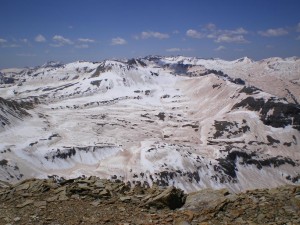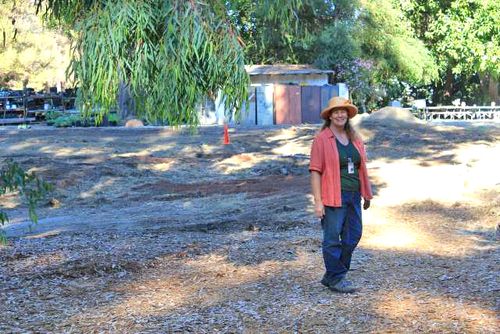High good, low bad: Mead in September 2010
Posted on | October 1, 2010 | No Comments
Seventy five years ago, President Franklin Delano Roosevelt dedicated Hoover Dam. The concrete is looking good. The thing showing its age is the Colorado River water impounded behind it. The elevation of Lake Mead, the storage reservoir serving California, Arizona, Nevada and the Republic of Mexico, dropped last night to 1,083.83 feet, the lowest closing elevation for September since 1937. That year, the world’s then largest reservoir was still filling. Now its over-allocated water is steadily disappearing. Elsewhere in the Bad News Department, the river serving it is unlikely to be flush this coming winter according to a new study comparing drought stress evident from tree rings and ocean currents. Rather, in Long-Term Relationships Between Ocean Variability and Water Resources in Northeastern Utah, RAND Corp researcher Abbie Tingstad and UCLA geographer Glen MacDonald suggest that a strengthening La Nina combined with the Pacific Decadal Oscillation and the Atlantic Multidecadal Oscillation could mean that the Pacific is cooking drought soup for the Colorado River watershed. Their study is in the October issue of the Journal of the American Water Resources Association. To let numbers tell the story, click here for month-on-month and year-on-year Lake Mead elevations going back to 1935.
Tags: chance of rain > Emily Green > Lake Mead > US Bureau of Reclamation
October fully loaded
Posted on | September 30, 2010 | No Comments
Click on the ten for a full October calendar of plant sales, classes, lectures and hikes.
The week that was, 9/19-25/2010
Posted on | September 26, 2010 | 1 Comment

Dust-covered snow in the San Juan Mountains of the Upper Colorado River basin, May 2009. Source: NASA/JPL-Snow Optics Laboratory. Click on the image to be taken to the report summary.
In the semi-arid regions of the Colorado Plateau and Great Basin, winds blow desert dust east, triggering dust-on-snow events. When dark dust particles fall on snow, they reduce its ability to reflect sunlight. The snow also absorbs more of the sun’s energy. This darker snow cover melts earlier, with some water evaporating into the atmosphere. — NASA study shows desert dust cuts Colorado River flow, NASA press release, September 20, 2010
… the “first-in first-served” system of allocating water rights has not worked in areas of high demand and must be overhauled. — Reference to a New Zealand study by the Land and Water Forum of proposed water management overhauls, Tougher controls on water likely, Dominion Post, September 23, 2010
Click here to keep reading ‘The week that was’
The Dry Garden: Wild in Westwood
Posted on | September 24, 2010 | 2 Comments

Katarina Eriksson, former manager of the herb garden at the Huntington and now manager of Rancho Santa Ana Botanic Garden's new Grow Native Nursery in Westwood. She stands on a site that last week was about to be leveled to make way for 10,000 plants. In a partnership with the federal Department of Veterans Affairs, returned servicemen and women will be working with Eriksson in the nursery, which opens this weekend. Click on the image for more information. Photo: Emily Green
For many Southern Californians, switching from a conventional landscape to a native plant garden starts on the freeways.
The best nurseries can be a long drive away. Only in recent years have some native plant outposts crept into relatively central parts of Los Angeles. The Theodore Payne Foundation for Wildflowers & Native Plants runs the most fragrant stall at the Sunday Hollywood Farmers Market, and in January Rancho Santa Ana Botanic Garden began selling California natives on Thursday afternoons at the Westwood Farmers Market.
This weekend marks Rancho’s expansion of that Westwood enterprise into a standing garden center in a dreamy sliver of West Los Angeles running from Constitution Avenue nearly to Sunset Boulevard. Depending on whom you ask, it’s 12 acres, 15 acres or even 25 acres. Whichever figure is right, it’s an enchanting site in a secluded vale sheltered by old stands of eucalyptus.
Click here to keep reading in the Los Angeles Times about the new native plant nursery from Rancho Santa Ana Botanic Garden. Also watch the Times print edition this weekend for the fall planting special, which will include a piece on growing natives in containers by crack gardener and environment writer Ilsa Setziol.
An effective teacher
Posted on | September 19, 2010 | 8 Comments
With apologies to its followers, “The week that was” is postponed and will return next Sunday. I am cleaning up after a party, and not any party, but a farewell party for Michelle Ereckson, who after more than a decade teaching at 24th Street Elementary School in Los Angeles has transferred to a campus closer to her new home.
Those who believe in the test score rankings of teacher effectiveness compiled by the Los Angeles Times will be neither impressed nor horrified by Michelle. The Times, in its statistical beneficence, rates her as “average.” Click here to keep reading about Michelle Ereckson’s contributions to 24th Street Elementary School
« go back — keep looking »



